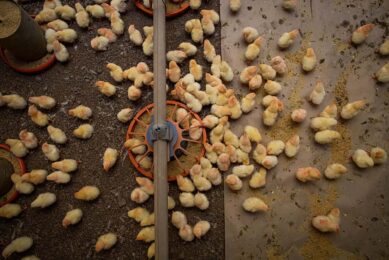Brazil from dormant giant to agribusiness powerhouse

In recent decades Brazil awoke as a major player in the international agribusiness. Apart from its traditional role as a beef country, also the poultry business really took off. In August this year, Brazil will host the XXIV Worlds’ Poultry Congress and Show.
By Fabio G. Nunes, Poultry Processing Consultant, Curitiba, Brazil
Brazil, 8,512 million square kilometers, fifth largest country in the world and the largest in South America, has been Latin America’s leading economic power since the 1970s. Presently one of the fastest growing emerging economies in the world, Brazil has been expanding its political and economical presence in the global marketplace. Since 2003, the country has steadily improved its macro-economic stability, turning out to be a net external creditor in 2008, while a US$ 2.05 trillion GDP in 2011 ascended Brazil to the sixth position among the worlds’ largest economies.
Yet plagued by striking asymmetries on many diverse fronts, Brazil is strongly committed to minimising these differences by counting on its growing economy’s solidness that has been paving the road towards a better future for the nation. In this context, Brazil’s agribusiness strength; plenty of resources, two grain crops a year, unmatched agricultural exports worth US$ 95 billion in 2011 and leading producer and exporter of several agricultural products, has played a crucial role.
Grain and meat
Brazil’s grain production jumped from 57 million tonnes harvested from 37 million hectares of cropland in 1990, to 160 million tonnes extracted from 48.7 million hectares in 2011, a 255% growth in production and just 30% growth in the cropland area. A key driver of this successful, sustainable performance is the Brazilian Agricultural Research Corporation (EMBRAPA), a public company set up in 1973.
Brazil’s grain production jumped from 57 million tonnes harvested from 37 million hectares of cropland in 1990, to 160 million tonnes extracted from 48.7 million hectares in 2011, a 255% growth in production and just 30% growth in the cropland area. A key driver of this successful, sustainable performance is the Brazilian Agricultural Research Corporation (EMBRAPA), a public company set up in 1973.
Triumphant, is Brazil’s meat industry. Benefiting from the country’s comfortable feed grains production self-sufficiency and supported by the livestock’s sanitary status, modern production techniques and the quality of its products, the sector has gained unparalleled competitiveness, decisive to push the domestic consumption up and to expand the overseas markets where Brazil obtained US$ 15.5 billion revenue from meat exports in 2011. The nearly 100% grass-fed commercial beef herd of 205 million heads is the world’s largest.
In 2011, Brazil produced 8.6 million tonnes and exported 1.45 million tonnes, ranking first among world producers and exporters. Domestically, the annual consumption per capita nears 39 kg. The pork industry takes a prominent role. Controlling from pure lines through finished animals and employing front running genetics and production technology, the sector ranks Brazil fourth among world producers and exporters, having produced 3.22 million tonnes of pork and exported 582 thousand tonnes in 2011.
Turkey and eggs
Brazil’s turkey industry has been flying high especially in the export market, yet more modestly than its peers. In 2011 Brazil’s production reached 305,000 tonnes with exports reaching 141,200 tonnes. Mostly processed meat, 71,870 tonnes, the exports had EU as main destination. Brazil is the fourth largest producer, but second largest exporter of turkey meat, right behind USA.
Brazil’s turkey industry has been flying high especially in the export market, yet more modestly than its peers. In 2011 Brazil’s production reached 305,000 tonnes with exports reaching 141,200 tonnes. Mostly processed meat, 71,870 tonnes, the exports had EU as main destination. Brazil is the fourth largest producer, but second largest exporter of turkey meat, right behind USA.
Duck, goose and other poultry meats, with marginal representation in the Brazilian domestic market, had exports of 1,640 tonnes of meat worth US$ 7 million. The main destinations were Asia, 1,208 tonnes (Japan, 817.7 tonnes and Hong Kong, 362 tonnes); Middle East, 347 tonnes (UAE, 111.5 tonnes) and Africa, 60 tonnes. Brazil’s shell egg production totalled 31.5 billion dozens, 1.9 million tonnes in 2011, translating to 162.5 eggs per capita, against 148.8 eggs per capita in 2010. The exports totalled 16,600 tonnes and US$ 28.2 million revenue. Africa imported 11,200 tonnes (Angola 10,600 tonnes) and Middle-East 3,000 tonnes (UAE).
Poultry production jumps
Nevertheless, the jewel in the crown is Brazil’s poultry industry. Already an organised activity since late 1950’s, it just peeped the egg in the mid-70’s, following the first exports. Growing fast from there on, but gaining a special momentum in the early 2000’s, Brazil’s poultry industry conquered a respectful reputation domestically and abroad in a relatively short time: from a production of 273,000 tonnes of meat and a per capita consumption of 2.3 kg in 1973, it jumped to 13.2 million tonnes of meat and a per capita consumption of 47.4 kg in 2011. Exports, from a mere 3,690 tonnes sent to Saudi Arabia in 1975, grew to 4 million tonnes sent to almost 160 countries in 2011.
Nevertheless, the jewel in the crown is Brazil’s poultry industry. Already an organised activity since late 1950’s, it just peeped the egg in the mid-70’s, following the first exports. Growing fast from there on, but gaining a special momentum in the early 2000’s, Brazil’s poultry industry conquered a respectful reputation domestically and abroad in a relatively short time: from a production of 273,000 tonnes of meat and a per capita consumption of 2.3 kg in 1973, it jumped to 13.2 million tonnes of meat and a per capita consumption of 47.4 kg in 2011. Exports, from a mere 3,690 tonnes sent to Saudi Arabia in 1975, grew to 4 million tonnes sent to almost 160 countries in 2011.
No doubt, the unparalleled competitiveness of Brazilian chicken meat domestically and abroad, the unquestionable sanitary status of the livestock and the products quality and safety, are key factors behind the industry’s rapid growth. However, its creativity to develop an endless succession of tasteful, convenience-added products, conquering consumers’ by the stomach, its promptness to comply with the international trade regulations and its capabilities to supply, simultaneously, complexes, tailor-made mixes of products to its many clients, are the main drivers behind the sectors’ astonishing trajectory.
Consolidation process
Among the many Brazilian companies, Doux and Tyson are the only foreign companies in the industry, which is relatively fragmented. The “Top 50” companies account for some 80% of the annual slaughter, but geographically concentrated, near to 70% of the production and about 75% of the exports originates from Brazil’s three Southern states.
Among the many Brazilian companies, Doux and Tyson are the only foreign companies in the industry, which is relatively fragmented. The “Top 50” companies account for some 80% of the annual slaughter, but geographically concentrated, near to 70% of the production and about 75% of the exports originates from Brazil’s three Southern states.
Over the last few years the sector has undergone an unavoidable and irreversible consolidation process, which wiped out a number of small and medium size independent companies from the marketplace. The most wowing operation was Sadia and Perdigão merging, then the first and second largest protein companies in Brazil, which began in 2009 was approved by late 2011, but not without heavy restrictions from the anti-monopoly authorities.
Brasil Foods (BRF), the merge-resulting company, is gigantic: Brazil’s top-5 exporter and largest meat exporter; world largest chicken exporter (140 countries); US$ 20 billion plus annual revenue; 115,000 employees; 61 plants in Brazil and 7 abroad besides 24 commercial offices worldwide. Brazil’s chicken industry is institutionally represented solely by the Brazilian Association of Poultry Producers and Exporters, UBA-BEF (www.abef.com.br), which also congregates the other chain stakeholders.
Expanding internationally
In response to the demand imposed by business globalisation, a few Brazilian meat companies started a robust and rapid internationalisation process about five years ago. This transnational move first led Perdigão to acquire Friki, an important Dutch meat processor, and JBS and Marfrig to acquire successive beef companies in Argentina, Australia, Uruguay, Paraguay and USA (among others, Swift, acquired by JBS), establishing a strong foothold in cattle production and/or beef processing sectors in those countries. Thereafter, the process zeroed in on chicken companies with the same intensity; JBS acquiring leading US poultry giant Pilgrim’s Pride, Marfrig acquiring Irish Moy Park and BRF acquiring, more recently, Argentinean Avex. To finally target food companies – US Keystone Food was acquired by Marfrig. Last but not least, BRF announced recently a new meat processing plant in the UAE and a partnership with giant Chinese Dah Chon Hong to produce and distribute its products in China. Who’s next?
In response to the demand imposed by business globalisation, a few Brazilian meat companies started a robust and rapid internationalisation process about five years ago. This transnational move first led Perdigão to acquire Friki, an important Dutch meat processor, and JBS and Marfrig to acquire successive beef companies in Argentina, Australia, Uruguay, Paraguay and USA (among others, Swift, acquired by JBS), establishing a strong foothold in cattle production and/or beef processing sectors in those countries. Thereafter, the process zeroed in on chicken companies with the same intensity; JBS acquiring leading US poultry giant Pilgrim’s Pride, Marfrig acquiring Irish Moy Park and BRF acquiring, more recently, Argentinean Avex. To finally target food companies – US Keystone Food was acquired by Marfrig. Last but not least, BRF announced recently a new meat processing plant in the UAE and a partnership with giant Chinese Dah Chon Hong to produce and distribute its products in China. Who’s next?
Brazil hosting WPC 2012 The 24th world congress and show of the World’s Poultry Science Association (WPSA), will be held in Salvador, Brazil from August 5-9 this year. This congress coincides with the celebration of the 100th anniversary of WPSA. The World’s Poultry Congress (WPC 2012) will be held at the Convention Center of the city of Salvador in Bahia state. It will cover important aspects of the meat and egg production chain, from the most elementary fields, live production (management, nutrition, health, environment, and animal welfare) to processing technologies and presentation of the final product. Hundreds of scientific studies from all over the world will be presented by internationally renowned researchers and experts on poultry genetics, nutrition, health, and management. In addition, hundreds of companies are exhibiting at the show which takes place concurrently. |
More information
Join 31,000+ subscribers
Subscribe to our newsletter to stay updated about all the need-to-know content in the poultry sector, three times a week. Beheer
Beheer








 WP Admin
WP Admin  Bewerk bericht
Bewerk bericht